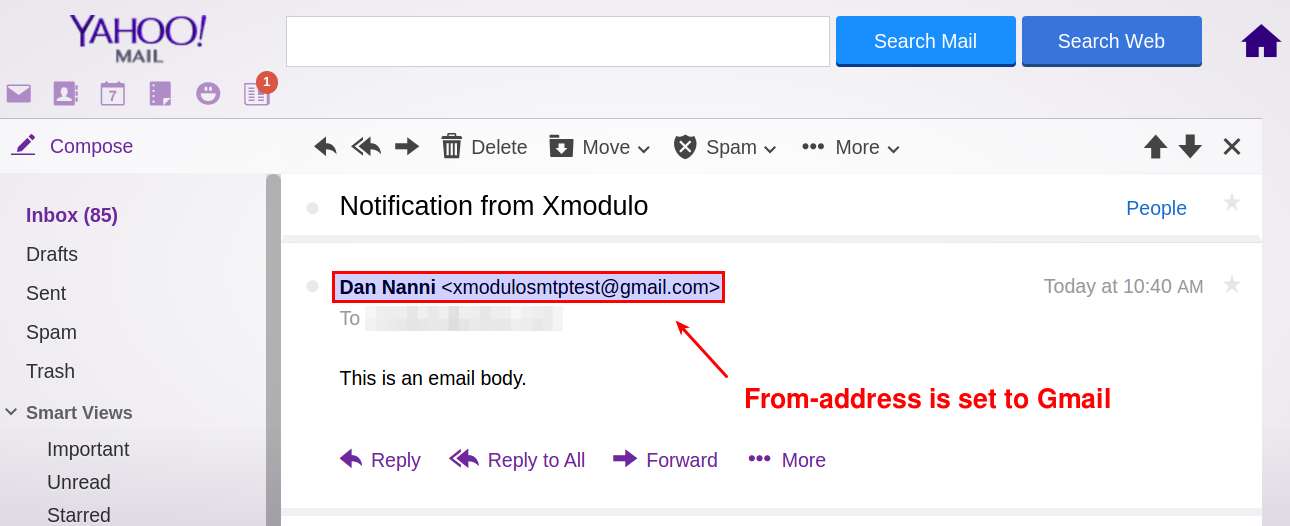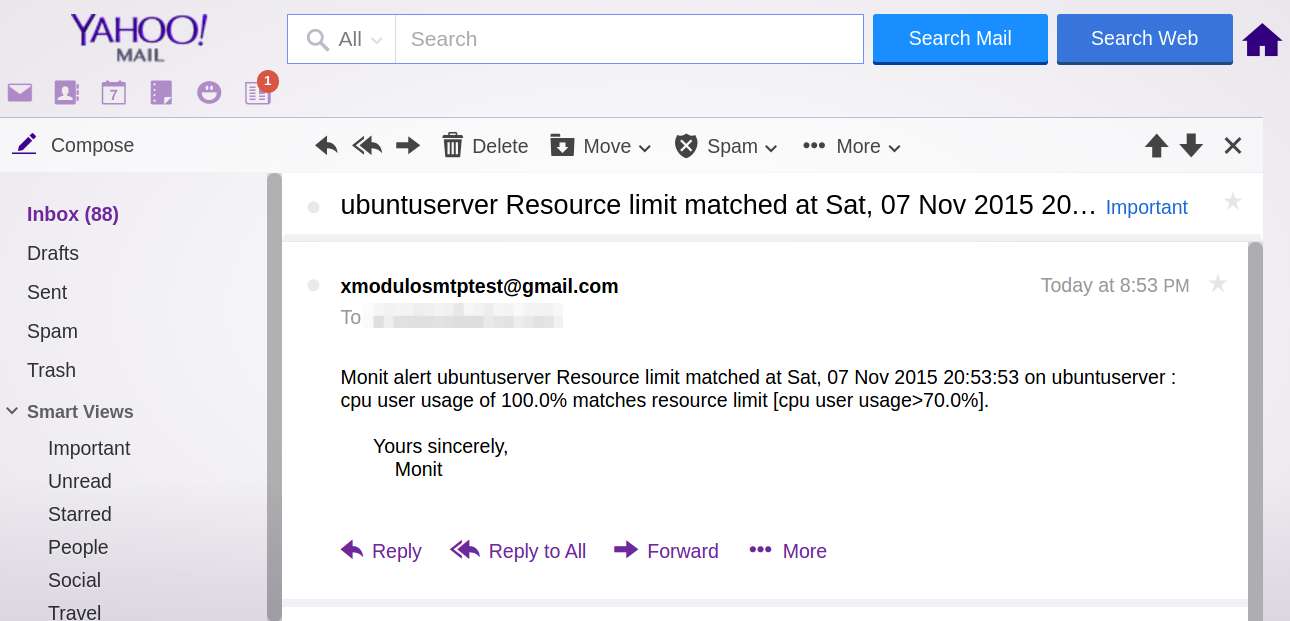How to send email notifications using Gmail SMTP server on Linux
Last updated on August 25, 2020 by Dan Nanni
Suppose you want to configure a Linux app to send out email messages from your server or desktop. The email messages can be part of email newsletters, status updates (e.g., Cachet), monitoring alerts (e.g., Monit), disk events (e.g., RAID mdadm), and so on. While you can set up your own outgoing mail server to deliver messages, you can alternatively rely on a freely available public SMTP server as a maintenance-free option.
One of the most reliable free SMTP servers is from Google's Gmail service. All you have to do to send email notifications within your app is to add Gmail's SMTP server address and your credentials to the app, and you are good to go.
One catch with using Gmail's SMTP server is that there are various restrictions in place, mainly to combat spammers and email marketers who often abuse the server. For example, you can send messages to no more than 100 addresses at once, and no more than 500 recipients per day. Also, if you don't want to be flagged as a spammer, you cannot send a large number of undeliverable messages. When any of these limitations is reached, your Gmail account will temporarily be locked out for a day. In short, Gmail's SMTP server is perfectly fine for your personal use, but not meant for commercial bulk emails.
With that being said, let me demonstrate how to use Gmail's SMTP server in Linux environment.
Google Gmail SMTP Server Setting
If you want to send emails from your app using Gmail's SMTP server, you need to adjust the security setting of the Gmail account to be used. Go to the Google account settings, and enable the option to allow less secure apps, which is off by default.
Then you will need to provide your app with the following details.
- Outgoing mail server (SMTP server):
smtp.gmail.com - Use authentication: yes
- Use secure connection: yes
- Username: your Gmail account ID (e.g.,
aliceif your email is[email protected]) - Password: your Gmail password
- Port:
587(TLS) or465(SSL)
Exact configuration syntax may vary depending on apps. In the rest of this tutorial, I will show you several useful examples of using Gmail SMTP server in Linux.
Send Emails from the Command Line
As the first example, let's try the most basic email functionality: send an email from the command line using Gmail SMTP server. For this, I am going to use a command-line email client called Mutt.
First, install Mutt as follows.
For Debian-based system:
$ sudo apt-get install mutt
For Red Hat based system:
$ sudo yum install mutt
Create a Mutt configuration file (~/.muttrc) and specify in the file Gmail SMTP server information as follows. Replace <gmail-id> with your own Gmail ID. Note that this configuration is for sending emails only (not receiving emails).
$ vi ~/.muttrc
set from = "<gmail-id>@gmail.com" set realname = "Dan Nanni" set smtp_url = "smtp://<gmail-id>@smtp.gmail.com:587/" set smtp_pass = "<gmail-password>"
Now you are ready to send out an email using Mutt:
$ echo "This is an email body." | mutt -s "This is an email subject" [email protected]
To attach a file in an email, use -a option:
$ echo "This is an email body." | mutt -s "This is an email subject" [email protected] -a ~/test_attachment.jpg

Using Gmail SMTP server means that the emails appear as sent from your Gmail account. In other words, a recipient will see your Gmail address as the sender's address. If you want to use your domain as the email sender, you need to use Gmail SMTP relay service instead.
Another note is that if you are concerned about placing your SMTP password in the plain-text .muttrc file, you can encrypt the password using GnuPG.
Send Email Notification When a Server is Rebooted
If you are running a virtual private server (VPS) for some critical website, one recommendation is to monitor VPS reboot activities. As a more practical example, let's consider how to set up email notifications for every reboot event on your VPS. Here I assume you are using systemd on your VPS, and show you how to create a custom systemd boot-time service for automatic email notifications.
First create the following script reboot_notify.sh which takes care of email notifications.
$ sudo vi /usr/local/bin/reboot_notify.sh
#!/bin/sh echo "`hostname` was rebooted on `date`" | mutt -F /etc/muttrc -s "Notification on `hostname`" [email protected]
$ sudo chmod +x /usr/local/bin/reboot_notify.sh
In the script, I use -F option to specify the location of system-wide Mutt configuration file. So don't forget to create /etc/muttrc file and populate Gmail SMTP information as described earlier.
Now let's create a custom systemd service as follows.
$ sudo mkdir -p /usr/local/lib/systemd/system $ sudo vi /usr/local/lib/systemd/system/reboot-task.service
[Unit] Description=Send a notification email when the server gets rebooted DefaultDependencies=no Before=reboot.target [Service] Type=oneshot ExecStart=/usr/local/bin/reboot_notify.sh [Install] WantedBy=reboot.target
Once the service file is created, enable and start the service.
$ sudo systemctl enable reboot-task $ sudo systemctl start reboot-task
From now on, you will be receiving a notification email every time the VPS gets rebooted.

Send Email Notification from Server Usage Monitoring
As a final example, let me present a real-world application called Monit, which is a pretty useful server monitoring application. It comes with comprehensive VPS monitoring capabilities (e.g., CPU, memory, processes, file system), as well as email notification functions.
If you want to receive email notifications for any event on your VPS (e.g., server overload) generated by Monit, you can add the following SMTP information to Monit configuration file.
set mailserver smtp.gmail.com port 587
username "<your-gmail-ID>" password "<gmail-password>"
using tlsv12
set mail-format {
from: <your-gmail-ID>@gmail.com
subject: $SERVICE $EVENT at $DATE on $HOST
message: Monit $ACTION $SERVICE $EVENT at $DATE on $HOST : $DESCRIPTION.
Yours sincerely,
Monit
}
# the person who will receive notification emails
set alert [email protected]
Here is the example email notification sent by Monit for excessive CPU load.

Conclusion
As you can imagine, there will be so many different ways to take advantage of free SMTP servers like Gmail. But once again, remember that the free SMTP server is not meant for commercial usage, but only for your own personal project. Also, for security reasons, it is a probably good idea to create a throw-away Gmail address just for email notifications, instead of using your own personal Gmail account. If you are using Gmail SMTP server inside any app, feel free to share your use case.
Support Xmodulo
This website is made possible by minimal ads and your gracious donation via PayPal or credit card
Please note that this article is published by Xmodulo.com under a Creative Commons Attribution-ShareAlike 3.0 Unported License. If you would like to use the whole or any part of this article, you need to cite this web page at Xmodulo.com as the original source.
Xmodulo © 2021 ‒ About ‒ Write for Us ‒ Feed ‒ Powered by DigitalOcean

